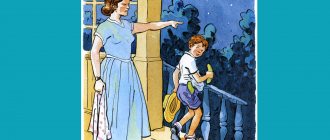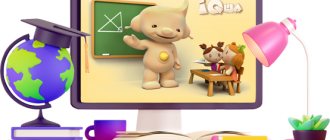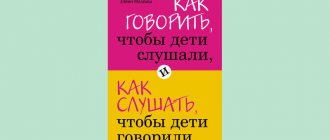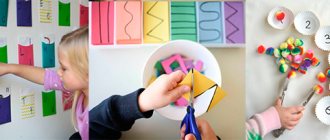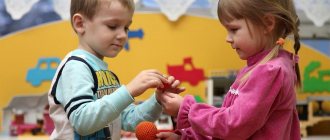For a child, play is not only a pleasant way to throw out his energy, but also the main way of learning about the world. Educational games in kindergarten with various objects have a significant impact on the development of the child as a full-fledged individual. For such games, a variety of objects are used: sticks, twigs, hammers, spoons, nets, etc. They are aimed at developing the child’s memory, logic, spatial thinking, and imagination.
Types of educational games in kindergarten:
- didactic games for junior and middle groups;
- outdoor games for preschoolers of all ages;
- role-playing games.
Goals of didactic games in kindergarten
Didactic games contribute to the comprehensive development of a preschool child.
Their goals:
- formation of ideas about objects and phenomena of the surrounding world;
- consolidation of knowledge about flowers;
- familiarity with geometric objects;
- formation of ideas about right and wrong actions and actions;
- nurturing positive personal qualities, the ability to interact with others;
- familiarization with counting and numerical characteristics;
- development of memory, speech skills, concentration, ability to think logically;
- emotional and creative improvement, development of imagination;
- improvement of fine motor skills, general coordination and motor response;
- development of respiratory ability.
pros
- Educational games allow you to maximize the work of each child in the team.
- Such games instill interest and respect for specialists in various professional fields.
- They introduce the rules of behavior of an intelligent person in society.
- They help children organize their own play activities (develop a play plot, assign roles for play, etc.).
- They form normal relationships between your son or daughter and the team, and develop communicative character traits in him.
- They develop the ability to perform a certain set of actions with objects of different shapes and sizes.
- Trains fine motor skills of the hands.
- Children are taught to distinguish objects from each other according to certain characteristic features.
- Helps you quickly memorize the names of objects.
- They teach you how to perform a simple set of arithmetic operations.
- Reinforce knowledge about geometric shapes and their properties.
- Helps learn the alphabet.
- Develop visual memory, auditory memory, imaginative thinking and observation.
- Expand vocabulary.
- They learn to focus and concentrate on one subject.
Educational games in kindergarten are very emotional, interesting and exciting. They contribute to the development of spatial thinking, creativity, and logic. These entertainments with kids help break down communication barriers and make children liberated and independent. Educational activities for kids are a reflection of the real world. With their help, children learn to live.
Didactic games for the younger group of kindergarten
At the age of 2-3, children actively get acquainted with the world around them and learn basic concepts. Didactic games for this age group are simple and involve one action. Group games are recommended; they teach kids to follow collective rules, develop communication and interaction skills to achieve goals.
Find a couple
For the game, prepare pictures of mittens and hats in 4 colors: green, red, yellow, blue.
Tell the children that the dolls are going for a walk. They have already put on their hats, but they can’t find mittens of the same color, they need help. Arrange the pictures chaotically on the table. The players' task is to find mittens that match the color of each hat.
Several people can play, each selecting their own 4 pairs. In this case, you can organize a competitive game: the first one to match all 4 pairs of mittens to the hats wins.
listen carefully
Give each student a flag. Play music or, if you are musically inclined, play an instrument. When the music is low, children should sit quietly with the flag down. And when the music starts playing loudly, the students raise a flag above their heads and wave it.
Make beads
For the game, prepare laces and beads of 4 colors: red, blue, green, yellow.
Tell the students that the dolls have gathered for the name day, but they have nothing to decorate themselves with. Offer to make beads, show the children laces and a box of colorful beads. The task is to select beads of a certain color from a box and attach them to a cord of a similar color.
The game can be competitive. 4 children play, each making beads of a given color. The one who finishes it faster than the rest becomes the winner.
Find your match
To play, make cardboard geometric shapes in different colors. Distribute the pieces in pairs according to the number of players.
Place the cards in a box and ask the children to take them out one at a time. Let the players look at the pieces, then find the same one from a friend. You can repeat the action many times. You can complicate it by dividing geometric shapes not only by color, but also by size.
Collect a picture
Prepare pictures for the game depicting objects familiar to preschoolers, cut them into 4 parts. Also place real objects in front of the children that match the pictures.
The players' task is to collect the picture. The player who completes the task correlates the resulting image with a real object. The winner is the one who first collects the picture and correctly points to the object corresponding to it.
Bad or good deed
Print out pictures with positive and negative stories for the game. Let the students look at the images and evaluate the actions of the characters. For example: “The boy pulled the girl’s pigtail. The girl began to cry. He did something bad."
Butterflies are flying
To play, cut out 5 butterflies from colored paper. Tie each one with a 50 cm thread. And secure the thread to a rope stretched horizontally. The distance between the figures should be approximately 40 cm, and their height should correspond to the eye level of the preschooler.
Tell them that butterflies fly beautifully. Blow on one of them, ask the students to do the same. Children take turns standing near the paper figures and blowing on them. The game is competitive, the one whose butterfly flies farthest wins. Make sure that players keep their back straight, do not tense their shoulders when exhaling, and do not puff out their cheeks. Each player exhales once, and it should last no more than 10 seconds, otherwise dizziness may begin.
Didactic games for the middle group of kindergarten
For preschoolers aged 3-4 years, didactic games are a way to expand their individual vocabulary and familiarize themselves with the objects of the surrounding world. Children learn the parameters and characteristics of objects, learn classification and comparison, and consolidate previously acquired knowledge.
When does this happen
For the game, prepare pictures with scenes from the daily life of a preschooler and place them in front of the students. When you say “morning,” children should look for images that correspond to that time of day, for example, brushing their teeth, doing exercises, combing their hair. Players who pick up the correct picture receive a point. The player with the most points wins.
Does this happen?
Say phrases relating to objects and phenomena of the seasons, and the students must say whether this happens. For example: “On a hot summer day, we left the house with a sled to go down the hill.” Or: “In the spring, birds began to gather in flocks to fly to the southern regions.”
What can you do in this place
Ask a question about a certain place, and the children must say what can be done there. For example: “On the river you can... swim, sunbathe, build sand castles, fish, ride a boat.” Or: “In the garden you can... weed the beds, water the plants, harvest the crops, set up a scarecrow.”
Name the signs
Say the words, and the children should take turns naming their signs. For example: a fox is red, cunning, beautiful, dexterous, tailed, fluffy. Or: the house is tall, brick, wooden, new, destroyed, spacious.
What does it sound like
For the game, prepare several boxes with different contents: sand, turf, grain, beans, pebbles. Demonstrate to the students what different substances sound like: shake each box. Then mix them up and, without showing the contents to the children, shake them again. Players must guess by the sound what substance is inside.
Shop
Organize an impromptu store, lay out various toys on the counter. Explain to children that they can buy a toy when they do not name it, but describe its features. Moreover, when describing, you cannot look at the item, so as not to give the seller a guess. The seller must, based on the signs presented, guess what kind of toy we are talking about and give it to the buyer. For example, a buyer says: “I need a round, bouncy, rubber toy.” The seller selects a ball.
Hide and seek
Organize a game on the kindergarten playground if there are a lot of trees and shrubs of different types. Or take your students to a city park.
Children choose who will search and hide behind trees and bushes. Your task is to guide the seeker, suggest where to look, without naming the type of plant. For example: “Find the one who hid behind a tall tree with a hollow and carved leaves.”
Name the action
Ask questions, and students must answer with verbs. The player who answers correctly receives a point. The one who collects the most points wins. For example: “What does the teacher do? - teaches a lesson, checks notebooks, educates, grades, writes on the board.” Or: “What can you do in the kitchen? “cook soup, peel potatoes, make tea, have lunch, wash dishes, bake pies.”
Educational games for children 3-4 years old in kindergarten card file (junior group)
Educational games for children 3-4 years old in kindergarten. https://razdeti.ru/razvivayuschie-igry-dlja-detei/…
Games for developing thinking for preschoolers 3-4 years old
Game "Who sleeps where."
Goals: to develop mental abilities, ideas about basic geometric shapes; assign a color name; form selection actions according to the model.
Game material and visual aids: cards divided into sectors (each sector contains a geometric figure).
Description: children remember the names of familiar human figures. The teacher distributes cards showing “beds” for each of the figures. The “little people” must be put to “sleep” in beds suitable for them, that is, all the figures must be laid out on cards so that they coincide with those drawn. For example: a person who has the shape of a square lies down in a crib of the corresponding shape.
Game "Endless classification".
Goal: to develop classification skills, attention, memory.
Game material and visual aids: cards with images of animals and some other objects.
Description: lay out all the cards. Invite your child to separate all the cards with images of animals. Next, animals are divided into wild and domestic. From the domestic ones, in turn, select those who have hooves and sort them into those with horns and those without horns. Animals can be classified according to the following characteristics: fluffy - smooth-haired, predator - herbivore, swims - does not swim, jumps - does not jump, etc.
Game “In the garden, in the vegetable garden...”.
Goals: develop classification skills; help explore the order of things.
Game material and visual aids: cards with images of a vegetable garden, garden, forest; figures of vegetables, fruits, berries, mushrooms (cut out of cardboard).
Description: invite the child to correctly distribute the cut out figures, remembering what grows where: vegetables - in the garden, berries and mushrooms - in the forest, fruits - in the garden.
Game “What should we put in the refrigerator?”
Goals: develop classification skills; help explore the order of things.
Game material and visual aids: cards with images of a refrigerator, wardrobe, china cabinet, bookcase, images of objects stored in the refrigerator, wardrobe, etc.
Description: tell your child a story about how one boy decided to indulge himself: he took out all the food from the refrigerator, clothes from the closet, as well as all the dishes and books. All the things were mixed up, and he could not put them back in place, but the boy’s mother would see and be upset. “Let’s help the child and put everything in its place: food next to the refrigerator, clothes near the wardrobe, books near the bookcase, dishes in front of the cupboard.”
Game "Find the picture".
Goal: to develop memory and attention.
Game material and visual aids: pictures of the same format with different images.
Description: show the child a picture. He must examine it carefully. Invite the child to turn away and lay out all the pictures, including the one previously discussed. Offer to find a picture that he has already seen.
Game "Guess the picture."
Goal: to develop attention, auditory perception, speech.
Description: Post several pictures with different images. For the first lessons, you should choose a drawing with a single subject. Invite the child to choose a picture, but do not say which one. Ask your child questions, the answers to which will lead to a solution. For example: “Does the picture you chose show an animal? Is this a wild or domestic animal? Is it with horns? With hooves? He has a long tail? Etc.". Offer to switch roles: the teacher makes a picture, and the child asks questions.
Game "What am I doing?"
Goal: to develop attention and imagination.
Description: invite the child to play an interesting game: the teacher imitates certain actions, and the child must guess what this means. For example: the teacher folds his fingers as if holding a pencil and moves his hand along an imaginary paper. The child must guess what the teacher is “drawing” or “writing.” You should show simple, understandable gestures (knock with a hammer, eat with a spoon, drink from a cup, throw a ball, etc.). Then switch roles.
Game "Who does it."
Goal: to develop speech, observation, logical thinking.
Description: invite the child to guess who the story is about. List the actions of this or that person. For example: comes home from work, has dinner, plays with you, goes with us to the park, circus, etc. (Mom or Dad.) Cuts hair, does hairstyles, works in a hairdresser. (Hairdresser.) Treats children and adults, wears a white coat, listens with a phonendoscope. (Doctor.)
Game "Who's Got It"?
Goal: to develop speech, attention, memory, observation.
Description: see the game “Who Does It” (objects that evoke associations with human actions are listed). Explain the rules to the child and start listing. For example: who has round brown glasses, a green jacket and a gift for you? (At Grandma's.) Who has a white coat, a phonendoscope, a white cap? (At the doctor.) Etc.
Game “The cow gives...”.
Goal: to develop attention and memory.
Game material and visual aids: cards with images of animals, products obtained from animals (milk, eggs, wool, etc.).
Description: Arrange the cards in random order. Invite the child, next to the image of each animal, to put an image of what this animal gives us. For example: chicken - egg, feathers (you can draw a pillow); cow - milk (cottage cheese, sour cream, kefir); goat - downy yarn (draw socks, mittens), etc.
Game "Narrow - Wide".
Objectives: to introduce the concepts of “narrow - wide”; develop matching skills.
Game material and visual aids: two balls of different sizes.
Description: invite the child to roll balls along a path fenced with cubes. Make two stripes - one for the small ball, the other for the large one. Roll a small ball along a wide path, then try rolling a large ball along a narrow path. Encourage your child to explain why the ball cannot fit on the small track. Introduce the concepts “narrow - wide” into your child’s active vocabulary. Experiment: move toys of different sizes along the paths. At the end of the game, generalize: a wide path is for large toys, a narrow path is for small ones.
Game "Comparison of quantities."
Goal: to develop comparative analysis skills, speech, logical thinking.
Game material and visual aids: wide and narrow strips of paper, cubes.
Description: invite the child to build houses for the mouse and for the bunny: “Do you think we will build them houses of the same size?” Encourage the child to conclude that the mouse’s house should be smaller than the bunny’s house.
After the houses are ready, tell them that the animals asked to put paths in front of their houses for guests. But to prevent guests from getting confused, the path in front of the mouse house should be narrow, and in front of the hare house - wide. Show your child how to determine which of the tracks (paper strips) is wider by placing them on top of each other. Let the child himself distribute the paths between the houses.
Game “How to distinguish them?”
Goal: to develop the skill of comparative analysis of objects by superimposing them on each other.
Game material and visual aids: identical geometric shapes with slight differences in size (cut out of paper).
Description: tell the child that the figures are cakes for dolls. Our scattered dolls mixed up all the cakes and cannot determine which is which. After all, the cake for Masha is larger than the cake for Olya, and the cake for Sveta is the smallest. We need to help the dolls. Let the child think about how this can be done. Show him how, by placing the figures on top of each other, he can figure out which cake is bigger and which is smaller. Give the dolls their dessert.
Game "Pick up a Christmas tree."
Goal: to develop matching skills, the ability to use words “above - below”, speech.
Game material and visual aids: Christmas trees (cut out of paper) of different sizes.
Description: draw a house. Tell your child about the boy who lives in this house. Draw snowdrifts near the house. Explain that New Year is coming soon. This means that you definitely need a Christmas tree: “Help me choose a Christmas tree that will fit in the house.” Place the Christmas trees on another sheet of paper. If the child cannot cope with the task, show him how you can compare the size of a Christmas tree and a house by placing a tree next to it. When placing the Christmas trees, comment: “No, this Christmas tree won’t suit us, it’s taller than the house, it won’t fit there. And this Christmas tree is too small, it’s lower than the house.”
Game “Does this happen?”
Purpose: to help study the category “above - below”.
Description: draw a multi-story house, next to it is a village house of the same size. Ask your child if it is possible for these houses to be the same size in real life? Finding out why this cannot be (many floors - one floor), means that a multi-story house is higher, and a village house is lower.
Game “How are they similar?”
Goal: to develop attention and observation.
Description: show the child two objects, ask him to talk about what these objects have in common, and then how they differ. For example: “Look at a ball and a cube of the same color.” General: both items are toys, both are the same color. Differences: the ball is round, the cube is square, the ball is large, the cube is small. To complicate the game, show the child objects with less pronounced differences, for example: two cars of the same color, but with different wheels, body shape, etc.
Game "Freight Train".
Goal: develop logical thinking.
Game material and visual aids: cards depicting objects of different categories (dishes, furniture, animals).
Description: invite your child to play with the train. Trains go to different cities and carry different goods. For example, a train going to Moscow is carrying dishes. Therefore, the pictures of the trailers should show items of this category. A train going to another city carries wild animals, etc. To complicate the game, lay out cards of different categories, but made of the same material, for example, wooden spoons, wooden chairs, wooden cubes, boards, etc.
Game "Guess what I'm talking about."
Goal: to develop logical thinking, memory, attention.
Description: invite the child to find an object in the room. Describe its location, color, shape, material from which it is made, etc. For example: “What I wished for is now under one of the chairs in this room. This object is small, round, rubber, red.” To complicate the game, in the future do not name the place where the object is located, listing all its other signs.
Game “What Happens...”
Goal: to develop speech, memory, and the skill of generalizing objects by attribute or property.
Description: the teacher asks the child questions, and he answers them. For example: “What is yellow?” (Chicken, sunshine, etc.); “What grows on a tree?”; "Who lives in the forest?" etc.
Game "What is it like?"
Goal: develop comparison skills.
Description: invite your child to play questions and answers. For example: “What is as round as a ball?” (Watermelon, orange, apple, etc.); “What is as white as snow?”; "What's as sweet as sugar?" etc.
Game "Show the path."
Goal: to develop fine motor skills and logical thinking.
Description: draw small images of animals in different places and, at a distance from them, what these animals eat as food. For example, if a hare is drawn on a piece of paper, then there should be a carrot or cabbage, a bear should have a barrel with the inscription “Honey”, a mouse – cheese, etc. Invite the child to draw lines that will show the animal where his favorite food is. You can play in accordance with the themes: “People - clothes”, “Animals - home”, “Tree - leaf”, etc. To complicate the task, draw several trees or flowers in the middle of the leaf, explaining to the child that the path should go around them.
Didactic games for the senior group of kindergarten
Didactic games, intended for preschoolers 5-6 years of age, involve the completion of complex tasks and the formation of correct relationships. In this age group, the educational and developmental process is built in the form of basic classes, and through games, children consolidate acquired knowledge and skills. The competitive process plays a significant role, promoting proper emotional development and establishing positive contact with other people.
Find the ball and name the color
Children stand in a circle. Stand in the center, throw the ball to each player in turn, and call a specific color. The player's task is to name the object with the appropriate color, then throw the ball back. For example: orange - orange, apricot, carrot. Or: purple - eggplant, plum, grapes, lilac.
Generalization
The players stand in a row. Throw a ball to each of them in turn, after naming a generalizing concept. Children must name objects that correspond to the generalization. For example: fruits - apple, orange, peach, pear, apricot, lemon.
Complete the drawing
To play, print out cards depicting shapes that can become part of an object. Laminate the images so that you can draw on them with erasable markers.
Show the children the cards and ask them what the shapes look like. Hand out the pictures to the players so that they can fill in what they represent. Then erase the images, change cards between players. And so on until each child has fantasized about all the figures.
Remember and find
The game should be organized in a spacious room in which kindergarteners can navigate well. Place any toys on the floor. Ask the player to look at them carefully and remember the location. Then blindfold the child with a scarf. The game task is to blindly find objects laid out on the floor.
Columbus egg
To play, print out the egg template, then cut along the lines into 10 shapes. From these figures you can create a variety of silhouette images. This activity is extremely fascinating for preschoolers and develops their imagination.
Who will collect the items faster?
The game is competitive. For her, prepare cards depicting objects that relate to different professions. For each player, or for a group of players if there are many children, determine a profession. The game's task is to find three pictures in a pile that relate to a given profession faster than others. For example: cook - cap, pan, ladle. Or: doctor - white coat, thermometer, syringe. Or: seamstress - thread, scissors, sewing machine. Or: builder - helmet, drill, trowel.
Complete the drawing
Give the players pictures of objects with missing parts, for example, a dog without a tail, a house without windows, a car without wheels. Children must say what is missing in the picture and complete this part.
Preparatory group
In the preparatory group, preschoolers prepare for the transition to first grade and acquire important knowledge and skills. Therefore, complex didactic games with a predominantly educational focus are applicable.
Train for animals
To play, make a cardboard train with 3 carriages: the first for animals, the second for birds, the third for insects. Print out pictures depicting fauna representatives. The game task is to correctly arrange the pictures into the cars.
Man or nature
Children stand in a circle. Throw a ball to each of them in turn, asking at random, “What did the person do?” or “What has nature done?” In the first case, the answers will be, for example, “car”, “clothes”. And in the second there is “tree”, “river”, “stone”, “nest”. The player who finds it difficult to answer is eliminated from the circle. The winner is the last one to give the correct answer.
Name the plant
Say a sound and the players must remember the plants that start with it. For example: A – aster, watermelon, orange, pineapple, aloe, acacia, cherry plum.
Clouds
On a fine day, when cumulus clouds float in the sky, take the students for a walk. Let everyone choose a cloud and tell them what it reminds them of.
Role-playing educational games
"The Hermit Crab and the Rose"
With the help of decorations, the illusion of a sunny sea coast is created. The main character is the hermit crab. He is completely alone, so the sea and the sun do not please him. He accidentally meets dolphins, who advise him to get a best friend. The hermit crab first tries to befriend the jellyfish, but she turns out to be indifferent to his need for friendship. Other sea inhabitants (crabs and moray eels) also do not want to see a friend in his face. Completely desperate, the crayfish swims to the algae and meets a beautiful sea rose there. He invites the rose to become his friend, and she cannot refuse him. At the end, the cancer and the rose dance a beautiful dance together as a sign of friendship.


